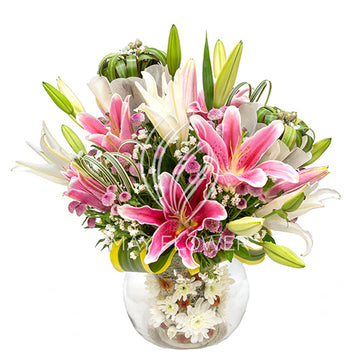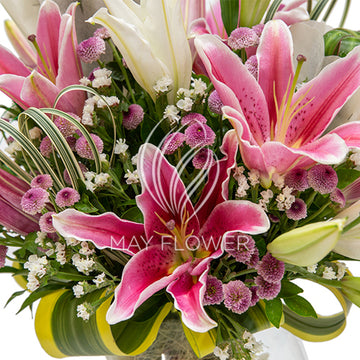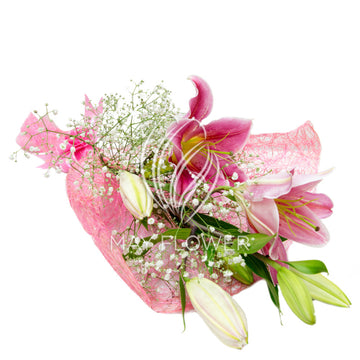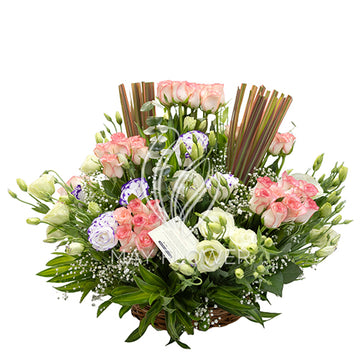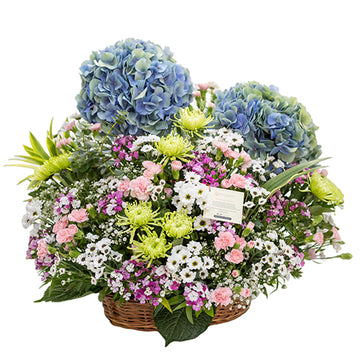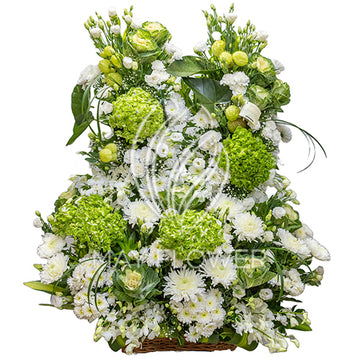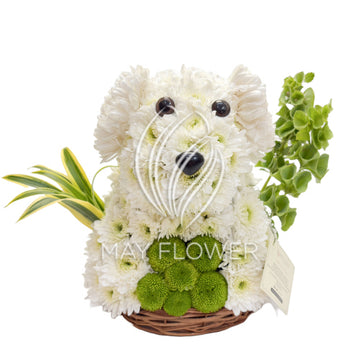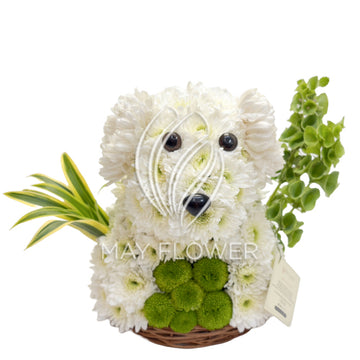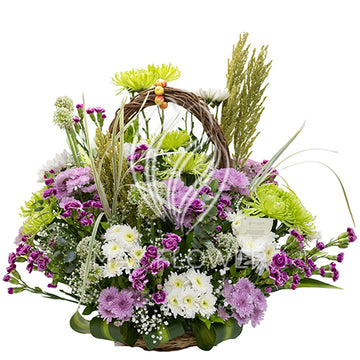Flower Exports from India
Government of India has identified floriculture as a sunrise industry and accorded it 100% export oriented status. Owing to steady increase in demand of flower floriculture has become one of the important Commercial trades in Agriculture. Hence commercial floriculture has emerged as hi-tech activity-taking place under controlled climatic conditions inside greenhouse. Floriculture in India, is being viewed as a high growth Industry. Commercial floriculture is becoming important from the export angle. The liberalization of industrial and trade policies paved the way for development of export-oriented production of cut flowers. The new seed policy had already made it feasible to import planting material of international varieties. It has been found that commercial floriculture has higher potential per unit area than most of the field crops and is therefore a lucrative business. Indian floriculture industry has been shifting from traditional flowers to cut flowers for export purposes. The liberalized economy has given an impetus to the Indian entrepreneurs for establishing export oriented floriculture units under controlled climatic conditions.
Agricultural and Processed Food Products Export Development Authority (APEDA), is responsible for export promotion and development of floriculture in India.
Varieties
Floriculture products mainly consist of cut flowers, pot plants, cut foilage, seeds bulbs, tubers, rooted cuttings and dried flowers or leaves. The important floricultural crops in the international cut flower trade are
rose, carnation, chrysanthemum, gargera, gladiolus, gypsophila, liastris, nerine, orchids, archilea, anthuriu, tulip, and lilies. Floriculture crops like gerberas, carnation, etc. are grown in green houses. The open field crops are chrysanthemum, roses, gaillardia, lily marygold, aster, tuberose etc.
Areas of Cultivation
Maharashtra, Karnataka, Andhra Pradesh , Haryana, Tamil Nadu , Rajasthan , West Bengal have emerged as major floriculture centers.
India Facts and Figures:
About 253.65 thousand hectares area was under Cultivation in floriculture in 2011-12. Production of flowers are estimated to be 1.652 million tonnes loose flowers and 750.66 million tonnes cut flowers in 2011-12.
Exports
The country has exported 27,121.88 MT of floriculture products to the world for the worth of Rs. 423.46 crores in 2012-13.
Major Export Destinations (2012-13): USA, Netherlands, Germany, United Kingdom, Japan, Canada and Japan were major importing countries of Indian floriculture during the same period.
India has a long tradition of floriculture. References to flowers and gardens are found in ancient Sanskrit classics like the Rig Veda (C 3000-2000 BC), Ramayana (C 1200-1300 BC), Mahabharata (prior to 4th Century BC), Shudraka (100 BC), Ashvagodha (C 100 AD), Kalidasa (C 400 AD) and Sarangdhara (C 1200 AD). The social and economic aspects of flower growing were, however, recognized much later. The offering and exchange of flowers on all social occasions, in places of worship and their use for adornment of hair by women and for home decoration have become an integral part of human living. With changing life styles and increased urban affluence, floriculture has assumed a definite commercial status in recent times and during the past 2-3 decades particularly. Appreciation of the potential of commercial floriculture has resulted in the blossoming of this field into a viable agri-business option. Availability of natural resources like diverse agro-climatic conditions permit production of a wide range of temperate and tropical flowers, almost all through the year in some part of the country or other. Improved communication facilities have increased their availability in every part of the country. The commercial activity of production and marketing of floriculture products is also a source of gainful and quality employment to scores of people.
Present Situation of Cut Flower Production
Inspite of the long and close association with floriculture, the records of commercial activity in the field are very few. The information on the area under floriculture and the production generated is highly inadequate. As commercial floriculture is an activity which has assumed importance only in recent times, there are not many large farms engaged in organised floriculture. In most part of the country flower growing is carried out on small holdings, mainly as a part of the regular agriculture systems.
Production Areas
The estimated area under flower growing in the country is about 65,000 hectares (Table 1). The major flower growing states are Karnataka, Tamil Nadu and Andhra Pradesh in the South, West Bengal in the East, Maharashtra in the West and Rajasthan, Delhi and Haryana in the North. It must, however, be mentioned that it is extremely difficult to compute the statistics of area in view of the very small sizes of holdings, which very often go unreported. This perhaps would be the reason for unrealistically small areas reported for floriculturally active states like Maharashtra, Uttar Pradesh and Madhya Pradesh.
More than two thirds of this large area is devoted for production of traditional flowers, which are marketed loose e.g. marigold, jasmine, chrysanthemum, aster, crossandra, tuberose etc. The area under cut flower crops (with stems) used for bouquets, arrangements etc. has grown in recent years, with growing affluence and people’s interest in using flowers as gifts. The major flowers in this category are rose, gladiolus, tuberose, carnation, orchids and more recently liliums, gerbera, chrysanthemum, gypsophila etc.
Area Under Flower Production in India
Karnataka 19,161
Tamil Nadu 14,194
West Bengal 12,285
Andhra Pradesh 5,933
Maharashtra 3,356
Rajasthan 1,985
Delhi 1,878
Haryana 1,540
Madhya Pradesh 1,270
Uttar Pradesh 1,000
Others 2,166
Total 64,768 hectares
The production of flowers is estimated to be nearly 300,000 metric tonnes of loose flowers and over 500 million cut flowers with stem. In the case of production also, the estimates could be at variance from the actual figures as some of the flowers like rose, chrysanthemum, and tuberose are used both as loose flowers and with stem.
It may be mentioned that almost all of the area reported here is under open field cultivation of flowers. Protected cultivation of flowers has been taken up only in recent years for production of cut flowers for exports. The estimated area in production is about 200 hectares, which is likely to increase to over 500 hectares by the year 2000.
Recognising the potential for low cost production for export, in view of cheap land, labour and other resources, several export oriented units are being set up in the country. These projects, located in clusters around Pune (Maharashtra) in the West, Bangalore (Karnataka) and Hyderabad (Andhra Pradesh) in the South, and Delhi in the North, are coming up in technical collaboration with expertise mainly from Holland and Israel. More than 90 percent of these units are for rose production, on an average size of 3-hectare farm, while some projects for orchid, anthurium, gladiolus and carnation are also being set up. Nearly one third of over 200 proposed projects, have already commenced production and export.
Major Cut Flower Crops
Rose is the principal cut flower grown all over the country, even though in terms of total area, it may not be so. The larger percentage of the area in many states is used for growing scented rose, usually local varieties akin to the Gruss en Tepelitz, the old favourite to be sold as loose flowers. These are used for offerings at places of worship, for the extraction of essential oils and also used in garlands. For cut flower use, the old rose varieties like Queen Elizabeth, Super Star, Montezuma, Papa Meilland, Christian Dior, Eiffel Tower, Kiss of Fire, Golden Giant, Garde Henkel, First Prize etc. are still popular. In recent times, with production for export gaining ground in the country, the latest varieties like First Red, Grand Gala, Konfitti, Ravel, Tineke, Sacha, Prophyta, Pareo, Noblesse. Virsilia, Vivaldi etc. are also being grown commercially.
Gladiolus is the next most important cut flower crop in the country. Earlier it was considered a crop for temperate regions and its growing was restricted to the hilly areas, particularly in the north eastern region, which still continues to supply the planting material to most parts of the country. However, with improved agronomic techniques and better management, the northern plains of Delhi, Haryana, Punjab, Uttar Pradesh, as well as Maharashtra and Karnataka have emerged as the major areas for production of gladiolus.
Tuberose, a very popular cut flower crop in India is grown mainly in the eastern part of the country i.e. West Bengal, and also in northern plains and parts of south. Both single and double flower varieties are equally popular. Tuberose flowers are also sold loose in some areas for preparing garlands and wreaths.
The other main cut flower item is orchid. Its production is restricted mainly in the north-eastern hill regions, besides parts of the southern states of Kerala and Karnataka. The main species grown are Dendrobiums, Vanda, Paphiopedilums, Oncidiums, Phalaenopsis and Cymbidiums.
Among the traditional crops grown for loose flowers, the largest area is under marigold, grown all over the country. In most parts of the country only local varieties are grown for generations. African marigolds occupy more area as compared to the small flowered French types. Jasmine flowers in view of its scent are also very popular as loose flowers and for use in garlands and Veni (ornament for decoration of hair by women). The major areas under this crop are in Tamil Nadu, Karnataka in South and West Bengal in East. The varieties are mainly improved clones of Jasminum grandiflorum, J. auriculatum and J. sambac. The chrysanthemum, particularly the white varieties are much in demand as loose flowers during the autumn period of October-December when other flowers like jasmine, tuberose are not available for use in garlands etc. Among other traditional flowers grown in large areas are crossandra in southern states of Tamil Nadu, Karnataka and Andhra Pradesh and aster in Maharashtra.
Research Support
Research work on floriculture is being carried out at several research institutions under the Indian Council of Agricultural Research and Council of Scientific and Industrial Research, in the horticulture/floriculture departments of State Agricultural Universities and under the All India Coordinated Floriculture Improvement Project with a network of about twenty (20) centres. The crops which have received larger attention include rose, gladiolus, chrysanthemum, orchid, jasmine, tuberose, aster, marigold etc. The thrust till recently had been on crop improvement, standardization of agro-techniques including improved propagation methods, plant protection and post harvest management. In view of the fact that most of the cut flower production is being done under open field conditions, the research efforts generally relate to open cultivation. In recent years, however, technologies for protected cultivation and tissue culture for mass propagation have also received attention. A large number of varieties suitable for cut flower use, as well as garden display have been developed. Production technology, particularly the agronomic requirements and control methods for important diseases and insect pests have also been developed. Contribution by the private sector in research activities in floriculture is negligible.
Planting Material
The requirement of planting material to cater to the large area under flower crops, is largely met from domestic production. Since efforts to set up large commercial farms generally suffered due to lack of quality planting material in sufficient quantities, this aspect has received greater attention in recent years in the breeding centres, which are producing sufficient quantity of planting material. Most of the nurseries propagating planting material are in the private sector. In the absence of any mechanism to register nurseries, it is very difficult to ascertain their exact number, but at a very conservative estimate there are more than 100,000 nurseries, spread out all over the country, producing seeds and other planting materials for flower growers. The states with larger numbers of nurseries include Maharashtra, West Bengal, Karnataka and Tamil Nadu. Most of the nurseries are small, with little or no improved facilities like mist propagation unit, green houses/net houses etc. For meeting the demand of flower seeds, several large seed companies have production units in Punjab, Himachal Pradesh and Jammu & Kashmir in the North, Karnataka in the South and West Bengal in the East. A few of the leading multinational seed companies have tied up with local seed companies or producers for custom production of seeds of their varieties. In the case of bulbous plants, most of the planting material is produced in the north eastern hilly regions of West Bengal (Kalimpong) and Sikkim, though for some crops, it is also produced in hilly regions of northern India. The introduction of a revised seed policy by the government of India in 1989 has enabled unrestricted introduction of many new and superior varieties into the country, increasing the variety in the floral basket.
Tissue culture has, in recent years, been recognized as an important tool in agriculture development. With its diverse climatic zones and qualified manpower, India is well placed to exploit the benefit of tissue culture based applications to floriculture crops. Most popular application of tissue culture has been micropropagation using in vitro technique for mass multiplication of planting material. Tissue culture plants of ornamentals have found ready acceptance by the commercial growers and their production increased significantly from 130 million plants in 1985-86 to 680 million in 1994-95. At present 30 commercial tissue culture units with annual capacities of 0.5 to 15 million plants each are in operation, resulting in total capacity of about 110 million plants. While most of it is exported, a small percentage of cut flower crops like carnation and
gerbera are finding good market within the country.
Marketing
Marketing of cut flowers in India is very unorganised at present. In most metropolitan cities, with large market potential, flowers are brought to wholesale markets, which mostly operate in open yards. A few large flower merchants generally buy most of the produce and distribute them to local retail outlets after significant mark up. The retail florist shops also usually operate in the open on-road sides, with different flowers arranged in large buckets. In the metros, however, there are some good florist show rooms, where flowers are kept in controlled temperature conditions, with considerable attention to value added service. The government is now investing in setting up of auction platforms, as well as organized florist shops with better storage facilities to prolong shelf life.
The packaging and transportation of flowers from the production centres to the wholesale markets at present is very unscientific. The flowers, depending on the kind, are packed in old gunny bags, bamboo baskets, simple cartons or just wrapped in old newspapers and transported to markets by road, rail or by air. The mode of transportation depends on the distance to the markets and the volume. Mostly, flowers are harvested in the evening time and transported to nearby cities by overnight trains or buses. In recent years, the government has provided some assistance for buying refrigerated carriage vans. A large number of export oriented units have built up excellent facilities of pre-cooling chambers, cold stores and reefer vans and their produce coming for domestic market sales are thus of very good quality and have longer vase life and command higher price. The government programmes for floriculture development include creating common facilities of cool chain in large production areas to be shared on cooperative basis. Formation of growers’ cooperatives/associations are being encouraged.
In view of the unorganized set up, it is difficult to estimate the size of flower trade, both in terms of volume and value. A study conducted in 1989 estimated the trade to be worth Rs. 2050 million. It is in the period of the last five years or so that this business has really boomed in India, which is reflected in the number of new florist outlets in all cities and increase in the public’s purchase of flowers as gifts. This would put the current trade at several times the earlier estimate. A recent study of Delhi market alone put the value of flowers traded on wholesale as Rs. 500 million.
The loose flowers (traditional crops like marigold, jasmine etc.) are usually traded by weight. The average price of different flowers in major markets varies considerably depending on the period of availability (Table 2).
Average Market Price for Major Flower Crops
Price (US$1 = Rs.40)
Rs./kg or doz or each stem
Marigold kg 3-60
Jasmine kg 15-150
Crossandra kg 20-120
Chrysanthemum kg 5-25
Tuberose kg 5-30
Rose kg 6-60
Gladiolus Doz 20-75
Carnation Doz 30-75
Gerbera Doz 36-75
Orchids each stem 10-45
Liliums each stem 10-45
Anthuriums each stem 15-45
The net returns to the growers depend on the packaging and transportation costs. The cut flowers with stem have a limited overall market in terms of volume. The share of cut flowers has almost doubled from 30 to 60% in the last decade.
The value of cut flower export from India has increased twenty five fold during the last five years (Table 3). With more export oriented units coming into operation, exports are likely to grow further in the coming years. The major share of the export trade is for roses, in addition to orchids, gladiolus etc. The major markets are Europe (Holland, Germany and U.K.) and Japan. The exports of roses to Japan, have really picked up in the three years from Rs. 360 million in 1993-94 to Rs. 6090 million in 1995-96. As per the estimates for 1996-97, India has been the largest supplier of roses to Japan (volume wise).
Potential for Cut Flower Production Development
The availability of natural resources like favourable and diverse climatic conditions permit production and availability of a large variety of flower crops round the year. Cheap labour leads to reduction in production costs, increasing access of the consumer to good quality flowers at affordable prices, besides increasing our competitiveness in the export markets. Being a new concept in the agri-business, it took some time for scientific commercial flower production to take roots, but with the appreciation of its potential as an economically viable diversification option, its growth is slowly stabilising. The government also has, during the last few years, recognized floriculture as an important segment for developmental initiatives. Model Floriculture Centres being set up in 11 major production zones, to serve as focal units for development in the region, have a mandate of making available quality planting material, new/improved production technologies and also to provide training in production and post harvest management. There are also special government programmes for area expansion in
floriculture with state assistance. The National Horticulture Board, a major developmental agency for horticulture, also makes available finances as soft loan for setting up integrated projects for production and marketing. As mentioned earlier, the government is investing in improving the infrastructure for marketing in the domestic sector.
Production of cut flowers for exports is also a thrust area for support. The Agricultural and Processed Food Products Export Development Authority (APEDA), the nodal organization for promotion of agri-exports including flowers, has introduced several schemes for promoting floriculture exports from the country. These relate to development of infrastructure, packaging, market development, air freight subsidy etc. The 100% Export Oriented Units are also given benefits like duty free imports of capital goods.
All these efforts indicate the government’s commitment for improving the sector and creating a positive environment for entrepreneurship development in the field.
Constraints in Cut Flower Production Development
Being a new concept, the requirements of scientific and commercial floriculture is not properly understood in the country. The developmental initiatives of the government have to keep in mind the low knowledge base, small land holdings, unorganized marketing and poor infrastructural support.
While long experience of flower growing in the open field conditions enable sufficient flower production for domestic markets, the quality of the produce, in view of its exposure to various kinds of biotic and abiotic stresses, is not suitable for the ever growing export market. The production technology for flowers under protected environment of green houses needs to be standardized. There is hardly any post harvest management of flowers for the domestic market. Availability of surplus flowers from exports for sale in the domestic market, has increased the appreciation of quality produce and the demand for good quality flowers is increasing. With the introduction of new varieties of crops in the country, facilities for generating their planting material for large scale production need strengthening. Special attention needs to be paid to strengthen the marketing infrastructure like organised marketing yards, auction platforms, controlled condition storage chambers etc.
Greater research efforts are also needed for integrated pest management, development of location specific package of practices for traditional flowers, value addition to traditional flowers etc.
The initial cost and availability of finance is a critical matter in the development of large commercial projects requiring heavy investments. More options for developmental finance, such as the soft loan scheme of the National Horticulture Board need to be identified. In the initial years of commercial floriculture development, the governmental support in terms of subsidies etc. needs special attention.
The potential for growth of export market is always linked to the strength of domestic market – its capacity to absorb surplus and over production, and quality consciousness of consumers. Though we have a large domestic market, the marketing system and facilities need to be modernized.
The production for exports at present has suffered due to a few constraints. While our growers have been successful in producing world class quality at low cost, high air freight rates, low cargo capacity available, imposition of import duties, inadequate export infrastructure etc. have reduced their competitiveness.
There is also a shortage of trained manpower to handle commercial floriculture activity. The demands of the growing export oriented industry would require adequate attention to be paid for human resource development, particularly at the supervisory level.
Conclusions
India has a long floriculture history and flower growing is an age old enterprise. What it has lacked is its commercialization. The growing demands of flowers in the domestic as well as the export market will require a concerted effort on the part of the government as well as the private entrepreneurs to develop floriculture on scientific lines. Paying attention to the input needs, better resource management and making various policies entrepreneur friendly would lead to a balanced growth of the industry.
Articles from Web Publishings and Magazine Articlies from Floriculture Media.
